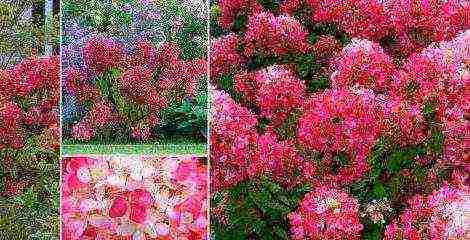Content
- 1 When is the best time to plant rhododendron?
- 2 Site selection and preparation of the landing pit
- 3 How to plant a rhododendron correctly?
- 4 Important rules for rhododendron transplant
- 5 How is outdoor rhododendron different from home grown?
- 6 Photo
- 7 Maintenance in summer, autumn, winter and spring
- 8 What to do after purchase?
- 9 How to plant: step by step instructions for beginners
- 10 Possible difficulties
- 11 How to care for shrubs outdoors?
- 12 Prevention of various problems in a garden flower
- 13 Diseases
- 14 Conclusion
Do you want to settle a bush of an attractive and flowering plant on your site? We will tell you when and how to properly plant rhododendrons in a flower garden and take care of them after planting.
Rhododendrons are rightfully considered the most beautiful spring-flowering shrubs. They have attractive evergreen leathery leaves. And the main decoration of the bush is large inflorescences. But to enjoy this beauty, the plant must be planted in a suitable place.
When is the best time to plant rhododendron?
The most optimal time for planting rhododendrons is early spring (when frosts pass, but the plants will not bloom yet) and early autumn (no later than mid-October). These shrubs have a shallow root system and large leaves that are very sensitive to drought, so wet and cool seasons are best for acclimating the rhododendron to a new location.
Site selection and preparation of the landing pit
Rhododendron prefers sunny or semi-shady areas where there is no gusty wind. The soil for the plant should be neither too light nor too heavy. The shrub tolerates drought and excess moisture equally poorly. Therefore, in growing rhododendron, the most important thing is to find a middle ground. Also, keep in mind that the acidity level of the soil should be between 4-5.5 pH. With an excess of acid, the shrub runs the risk of developing chlorosis.
Prepare a soil suitable for rhododendron as follows: mix sour peat, garden soil and pine bark in a ratio of 3: 0.5: 1. Then check the acidity level with litmus paper. In addition, perlite can be added to the soil mixture.
Dig a planting hole 0.5-1 m deep and 1-1.5 m wide. The hole should be 3-4 times the size of the root system of the rhododendron seedling.
How to plant a rhododendron correctly?
Put drainage (expanded clay or gravel) at the bottom of the pit, then fill the hole halfway with the prepared soil mixture. If you purchased a seedling with an open root system, spread the roots of the plant and carefully place it in the hole. Sprinkle abundantly with water at room temperature so that the roots go deeper into the soil. Fill the voids with the remaining nutrient soil, then lightly compact the earth, pour and mulch with pine bark.
Plant a seedling with a closed root system together with an earthen clod using the transshipment method.
Important rules for rhododendron transplant
If the place you have chosen is not suitable for the rhododendron, it needs to be transplanted. Fortunately, this plant tolerates habitat changes well due to its compact root system. However, some rules should be followed.
1. Transplant the rhododendron only in early spring or early autumn and always with an earthen lump. To prevent the soil from crumbling during transport, transport the shrub on a garden wheelbarrow or a piece of dense material.
2. When digging up a plant, it is important not to touch the roots. Otherwise, it will be difficult for him to settle down in a new place.
3. Transplant rhododendrons in cloudy and cool weather, as the scorching sun negatively affects the survival rate of plants.
4. The first time, until the shrub grows stronger in a new place, shade it on hot days and water regularly during a drought. In the first winter, be sure to protect a young plant (even cold-resistant varieties) from frost - mulch and cover with spunbond.
If you live in a region with an unstable climate, before planting this attractive shrub, take a look at the more cold-tolerant varieties. We wrote about them in the article Winter-hardy rhododendrons - 10 most beautiful varieties with photos and descriptions.
Based on materials from the website www.wymarzonyogrod.pl
 These shrubs are great during flowering. At the beginning of the 19th century, rhododendrons began to decorate the gardens of Russia for the first time. Varieties, cultivation in the open field, planting, care, reproduction: we cultivate rhododendrons according to all the rules.
These shrubs are great during flowering. At the beginning of the 19th century, rhododendrons began to decorate the gardens of Russia for the first time. Varieties, cultivation in the open field, planting, care, reproduction: we cultivate rhododendrons according to all the rules.
Description of rhododendron: varieties and varieties
The genus of rhododendrons is quite extensive - more than 1,000 species, which include various varieties of this wonderful plant. The natural area of distribution of rhododendrons is limited to the eastern countries: China, Japan, Korea, the Himalayas; some plant species are found in the Caucasus, North America, northern Africa and Australia. In European territory, two varieties of rhododendron grow in the mountainous regions of Germany.
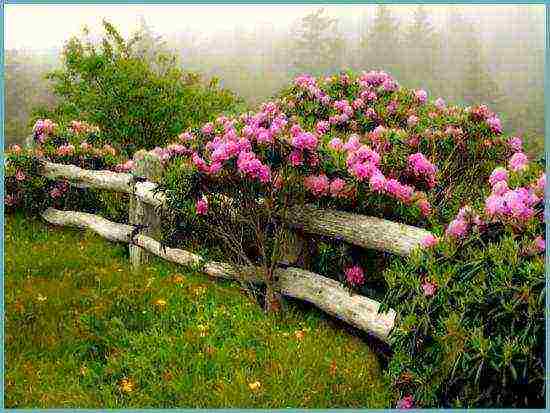
Rhododendron is a magnificent plant with a long flowering period
The culture refers to flowering deciduous or evergreen shrubs of the heather family. The branches of the plant can have smooth bark or pubescence. Leathery, dark green small ovoid leaves are sometimes pubescent. Bell-shaped flowers, funnel-shaped, simple and double. The color of the petals varies depending on the variety: white, pink, lilac, red, purple. Modern varieties of rhododendron are yellow and orange in color. Numerous small seeds ripen in capsules.
Rhododendrons, the cultivation of which is most acceptable on the territory of Russia, is limited to 26 species belonging to three groups of plants.
- Evergreens are tall shrubs that do not shed their dark leathery foliage even in winter. Large flowers are painted in different colors and tones. Growing evergreen rhododendrons in the open field requires compliance with a number of necessary rules: plants are placed in places with diffused shadow; the soil for them should include a large amount of peat.
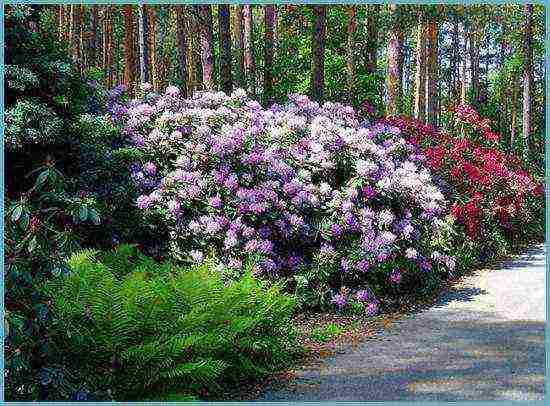
Rhododendron evergreen
Tip: It is important to choose the right neighborhood for evergreen rhododendron species, especially when decorating territories in landscape design. It can be all types of conifers, heather, ferns grown in the open field.
- Intermediate (semi-evergreen) - low shrubs that winter well under a layer of snow. The plant is characterized by a compact form, a huge number of flowers during the flowering period. In winter, most of the leathery leaves fall off, leaving only the whorl of leaves at the ends of the branches, from the center of which new foliage grows.
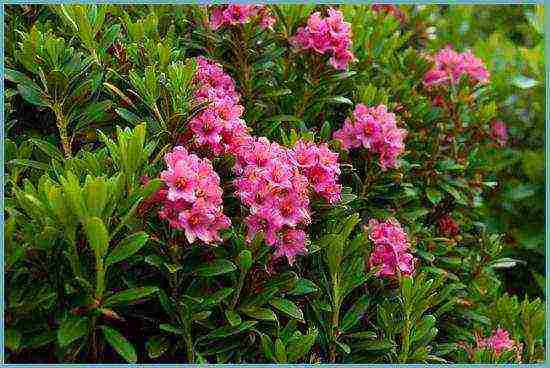
Semi-evergreen rhododendron
- Deciduous - rhododendrons of this group are most adapted to the conditions of the Russian climate. The cultivation of these plants is not difficult, and the plants themselves do not need to specially adapt in winter. Blossoming in spring, repeated in autumn.

Deciduous rhododendron, grade "Fireworks"
Planting a plant
Rhododendron: planting and caring for plants in compliance with agrotechnical rules - plant transplantation is allowed in spring and autumn. In autumn - in any of three months, in spring - in warm, well-established weather, when the soil is no longer frozen (usually April or May).
The choice of a place for planting a plant must be carried out with special care. Planting rhododendrons should be protected from the prevailing wind and direct sunlight. It is important that the shrub is accessible for viewing, then the decorative appearance of the plant during the flowering period will decorate the territory and please the eye.
Tip: Before planting the plant from the container into the open ground, it should be thoroughly saturated with water.
A planting hole for rhododendron bushes is prepared based on the actual size of the root system, and should be 2 times larger in volume. The natural soil should be removed completely. To plant a plant, it is required to prepare a special earthen soil consisting in equal parts of heather earth; peat; garden soil or leaf humus; rotted manure; needles (pine).
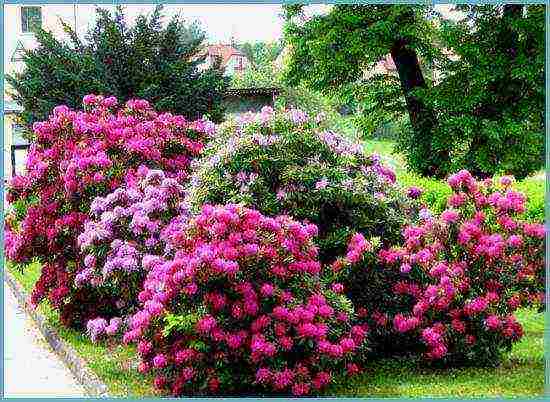
It is very important to plant the plant correctly, then it will quickly take root.
The prepared pit is filled with a mixture, a place is prepared in it for planting a rhododendron bush, which must be placed strictly vertically. The soil around the root system of the plant must be tightly squeezed - the formation of voids and "pockets" in the planting soil is not allowed. At a high level of groundwater, it is necessary to provide for the laying of a special drainage layer at the bottom of the pit. After planting, the top layer of soil should be mulched with peat chips.
Rhododendron: proper watering
Watering the planted plant is carried out at the time of planting, - abundant, sufficient to moisten the soil to a depth of 20-30 cm. Subsequent watering of the rhododendron should be done with soft, acidified water, with complete moistening of the soil.
Tip: When planting a plant with buds, it is necessary to remove most of them.
Plant care
A transplanted plant requires attention and careful care. In addition to regular abundant watering, the rhododendron needs spraying over the foliage, especially when planting in late spring. The soil needs to be mulched to maintain sufficient moisture. When mulching, you should choose options that increase the acidity of the soil.
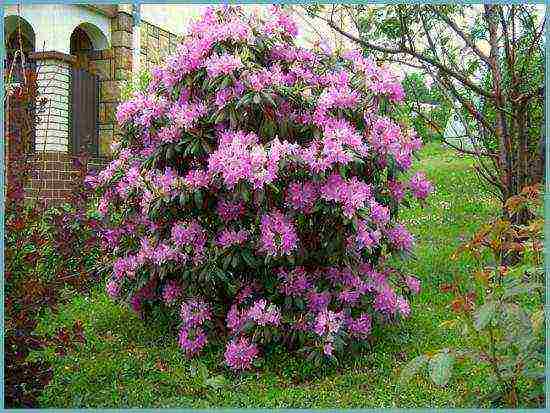
The plant needs regular watering
The root system of rhododendrons consists of delicate, fine hairs, similar to matted hair, so loosening the soil, especially deep, should be excluded from flower care measures. Weeds growing next to the plant need to be removed periodically.
The appearance of the plant will immediately inform about the lack or excess of water - the leaves of the rhododendron will begin to turn yellow and fall off. Watering is required in sufficient quantities, but without overflow, this is one of the main rules for caring for a crop.
To ensure proper care of the rhododendron, it is important to timely prune the overgrown bushes. Places of cuts to prevent infection of the plant are covered with paint or garden varnish.
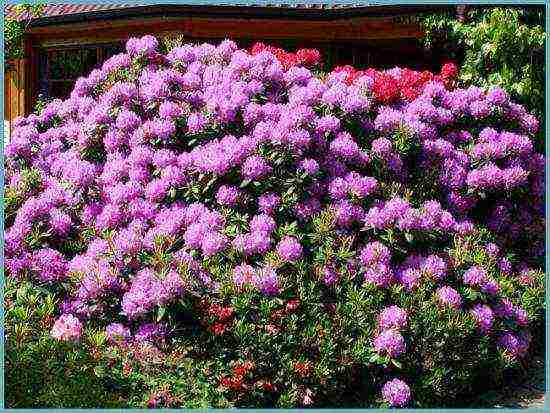
Bushes need to be pruned periodically
Compliance with simple plant care requirements will allow you to grow a wonderful flowering bush.
Fertilizing and feeding rhododendron
In the first year, the transplanted plants already require careful fertilization, which is applied in a highly diluted form, in small portions. The plant itself will signal the need for fertilization: it will stop growing, discard the foliage or the leaves change color, and the formation of flower buds will stop.
Organic fertilizer for feeding rhododendron bushes - semi-decomposed manure, which must be infused in water. Top dressing is carried out with an aqueous solution of manure. To increase the formation of flower buds, as well as to extend the flowering time, granular superphosphate, or double superphosphate, is used, which is scattered over the moist soil under the plants. The plant is also useful for fertilizing with microelements, - fertilizers are applied in the form of watering or spraying the green mass of the bush. Intensive fertilization of the bushes is required until the end of August.
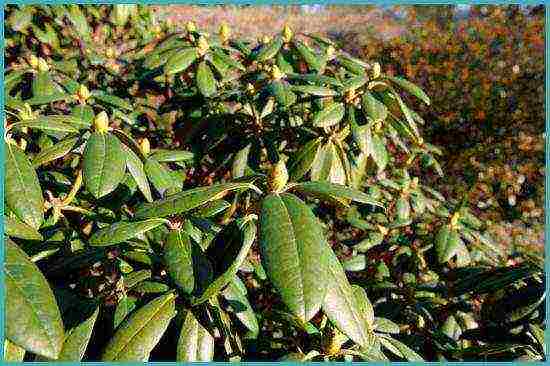
Rhododendron before flowering
Reproduction of rhododendron
Growing rhododendron involves plant propagation by layering and seeds, dividing the bush, grafting, cuttings.
Seed propagation Is a great way to get plants with improved traits. Sowing is carried out from the end of December to the end of March. The second period suitable for seed reproduction of rhododendrons is the end of November.
Sowing seeds is carried out in shallow bowls or boxes filled with a nutrient mixture of peat, sand, coniferous and sod land, taken in equal proportions. The seeds are pre-soaked for a day. Sowing is carried out on the top layer of the soil, without embedding deep into the soil. The sowing is moistened by spraying. It is required to provide seedlings with a 12-hour illumination with fluorescent lamps. The timing of seed germination depends on the variety. The first flowering of seedlings is possible in 3-4 years.
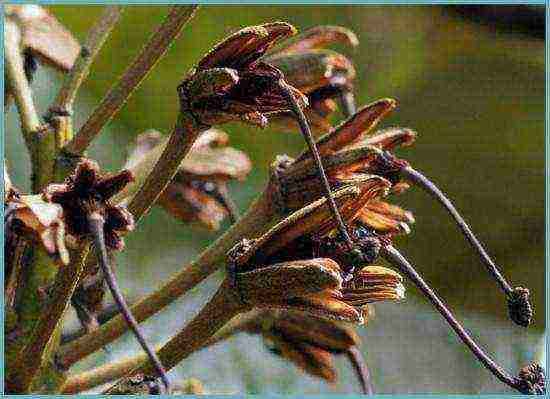
Rhododendron seeds
This method has its advantages, but with seed reproduction of rhododendrons, it takes up to 5-6 years to obtain full-fledged plants.
Faster new plants can be obtained with vegetative methods of culture propagation: cuttings, division of the bush, rooting of cuttings.
Diseases and pests
Fulfillment of the requirements for agricultural technology of rhododendrons guarantees excellent growth and development of plants. However, repeated waterlogging or overdrying of the soil, alkaline reaction of the soil, sunburn of leaves, can provoke a surge in crop diseases.
Plants can be damaged by spots, rust and chlorosis. Disease control measures - improving the conditions for keeping plants, the use of special means to combat diseases. Often rhododendron diseases are caused by pathogenic fungi: gray rot, fusarium, late blight.
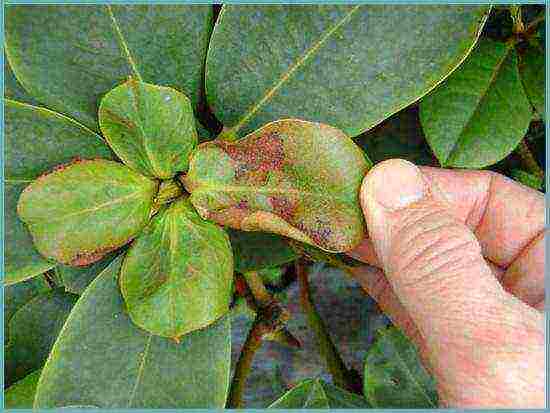
Spotting - a fungal disease of the rhododendron
Pests that damage rhododendrons: slugs and snails that eat young leaves and buds. The collection of these pests is done manually. In addition, the plant is harmed by: bedbugs (rhododendron), spider mites, mealybugs, weevils, scale insects, rhododendra fly. Pest control is easy with systemic insecticides.
Rhododendron: combination with other plants
Planting plants in combination with conifers and a group of heathers has a positive effect on the development of rhododendrons. It should be remembered about the height of the rhododendron bush. Low cultivars should be located away from the dense shade of mature trees, but avoiding direct sunlight.
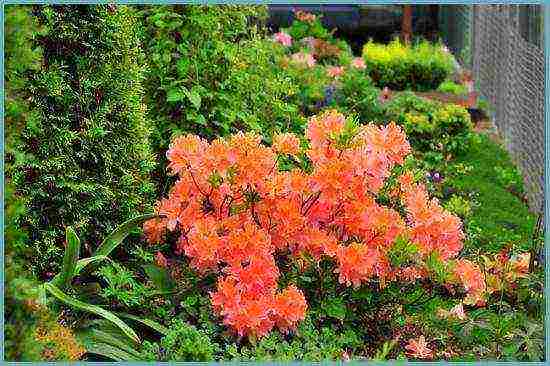
Blooming rhododendron perfectly sets off conifers
An excellent combination is observed when located next to the rhododendrons of shade-loving ferns and host.
Rhododendron in landscape design
In landscape design, rhododendron is an indispensable attribute for planting in partial shade. The huge advantages of the plant are its long and very decorative flowering. Rhododendrons are widely used in the design of heather gardens, as an addition to the planting of pine groves. The plant looks great in mono plantings.

Rhododendron in landscape design
Low-growing varieties of rhododendrons are planted near alpine hills, in mixborders and in decorative flower beds.
Planting a garden rhododendron: video
Types of rhododendron: photo
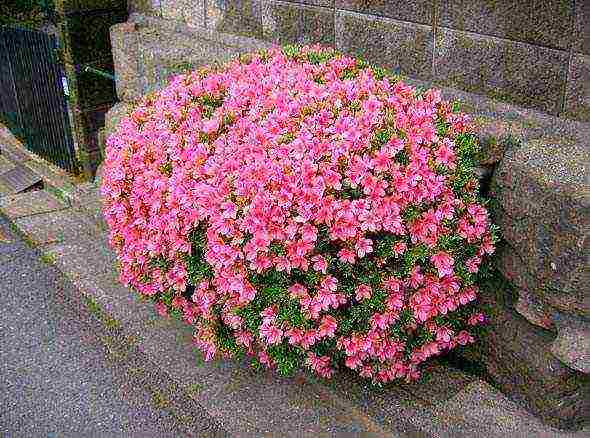
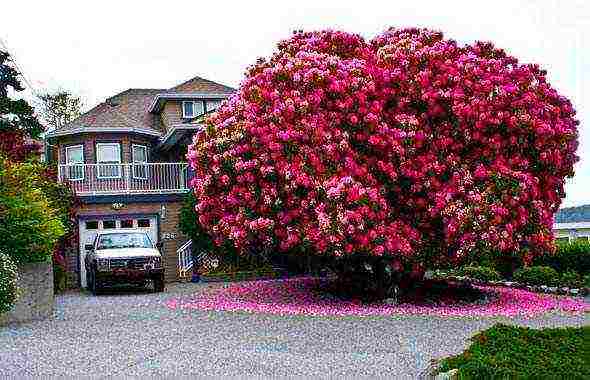
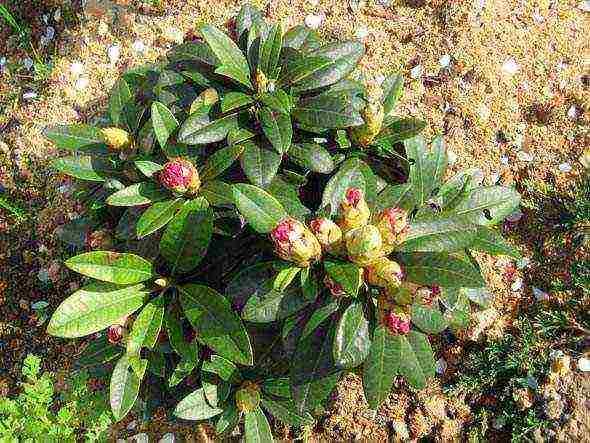
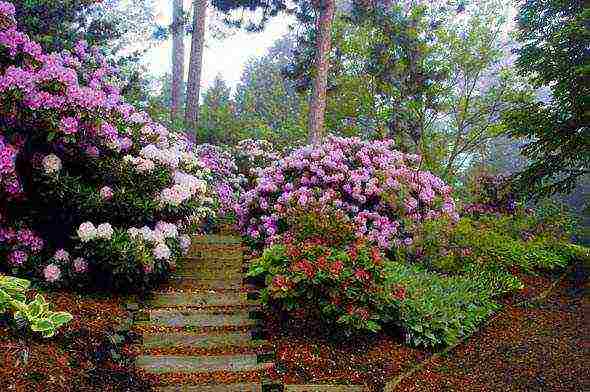

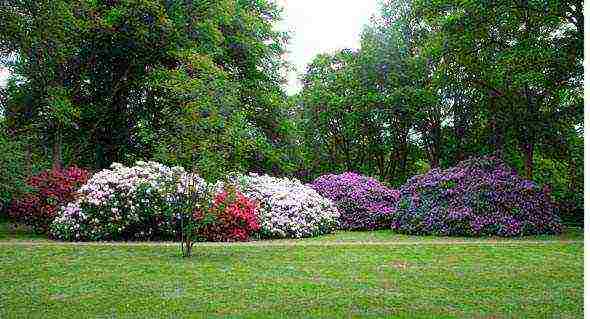
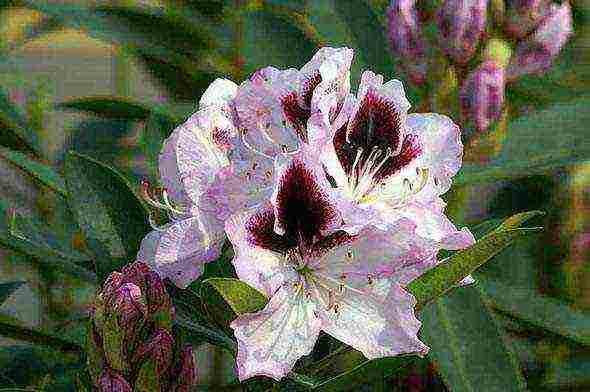
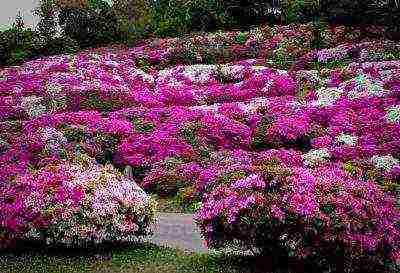
The amazing world of Azaleas and Rhododendrons is very mesmerizing. These plants seem somehow unreal, just unearthly. When you see this beauty during a powerful flowering, it is even difficult to take your eyes off. Naturally, I want to quickly plant all this at home or in the garden. An incomparable pleasure is to sit with a cup of coffee in the garden next to the blooming Azalea. In this article, you can find out how and when to plant a garden rhododendron and the peculiarities of its cultivation, as well as see a photo of a perennial azalea.
…
How is outdoor rhododendron different from home grown?
REFERENCE! All garden azaleas that are grown outdoors are called Rhododendrons, there is a very wide variety of species and care for them requires a careful approach.
Differences from indoor:
- Garden species differ from indoor ones in greater endurance.
- Flowering in the open field occurs in spring and summer, at home in winter.
- Indoor plants grow to about 30 cm, and garden forms can grow much taller.
Photo
Below you can see a photo of a garden azalea:
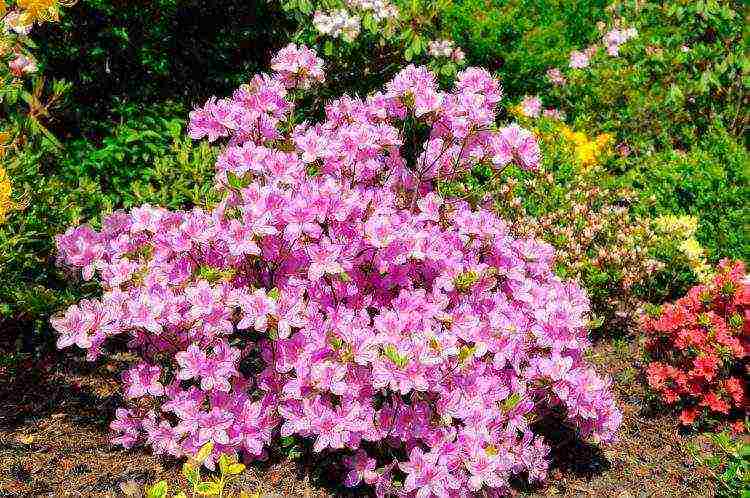
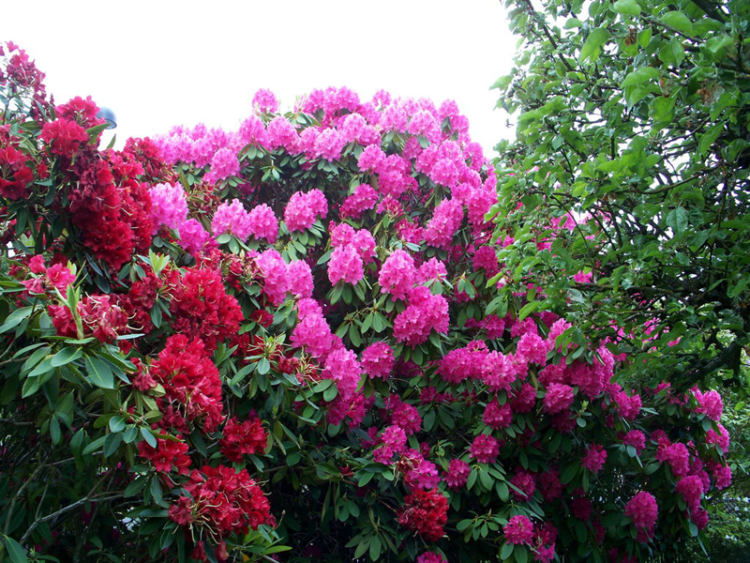
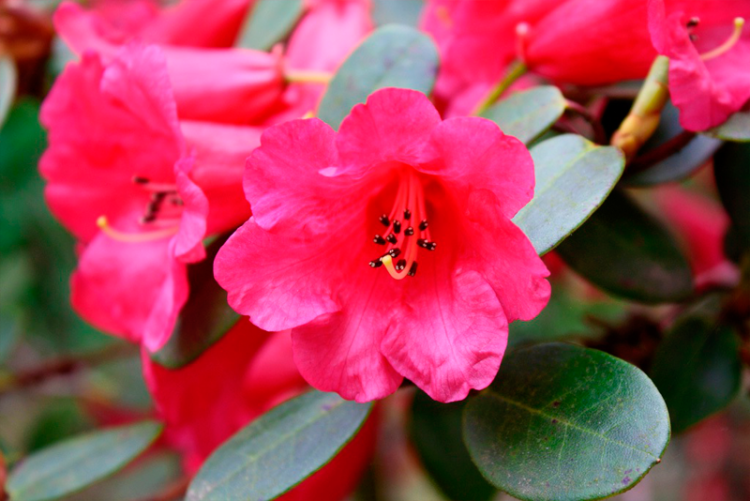

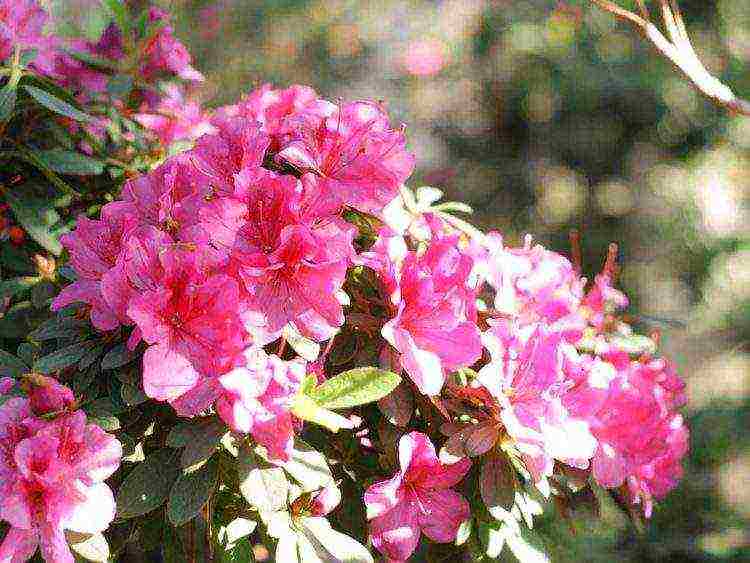
Maintenance in summer, autumn, winter and spring
- Spring care - in early spring (as soon as the frosts end), you need to remove the shelter, inspect the bush after wintering and, if necessary, remove the broken and dried branches. As soon as the threat of frost has passed and buds begin to form on the plant, you need to make additional fertilizing and water as needed.
- Summer care - at this time, you need to carefully monitor watering, the soil should not be allowed to dry out, it is also imperative to spray the plant with soft water. Water from a pond or rainwater is perfect, just do not splash on the flowers. We continue to apply top dressing (always at the beginning of flowering and at the end).
- Autumn care - gradually reduce watering, do not apply additional fertilizing. The main difference from a home room azalea is that in the fall it needs preparation for winter. This is the only way the plant can survive sub-zero temperatures. Before freezing, you need to deeply shed the bush and mulch it well with coniferous needles. When the frost begins, you should cover it with Spabond, having previously built a base in the form of a hut.
- Winter care - make sure that the bush does not break due to the abundance of snow, periodically tamp the snow at the base.
What to do after purchase?
Advice! After the purchase, we plant a new young seedling in the garden (it is better to do this in the spring) and immediately it is necessary to spray it with Epin solution for better adaptation.
Of course, at first it requires constant attention, it is imperative to water and spray in a timely manner. Top dressing during this period is not needed, the plant must first get used to the new place and conditions. And after 2 - 3 months we take care as usual.
How to choose the right one:
- Optimal planting time - the best time for planting is early spring, but if the need arose, you can plant it in summer; in the fall, it is better to refrain from planting.
- Landing place - you need to choose a place in partial shade, protected from the winds and not in the lowlands.
How to plant: step by step instructions for beginners
- Preparing inventory - we need gardening gloves, a pruner, a shovel, a bucket and a watering can.
- The soil - you need a loose, well-drained, fertile, acidic or slightly acidic, if your soil is completely different on the site, then you should add the necessary additives to the planting hole, otherwise the plant will not develop normally.
- How to plant a bushy street azalea:
 Prepare the planting pit and substrate in advance: mix the turf soil, leaf humus, sand, peat in equal quantities.
Prepare the planting pit and substrate in advance: mix the turf soil, leaf humus, sand, peat in equal quantities.- Pour broken brick or clay shards (medium-sized pieces) at the bottom of the pit, add a little prepared substrate.
- We put a seedling in the middle and fall asleep carefully. The root collar should remain above the ground from above, you cannot fill it up.
- Then you need to water, wait a little until the soil settles and add more.
- On top, form a near-stem circle and pour a layer of mulch (best of all from coniferous needles).
- First watering - after planting, the first watering should be done after 3 days with soft water.
- Further care after planting - the plant usually takes root easily, as soon as new leaves begin to appear, which means that our Azalea has taken root. Next, you need to clearly monitor the irrigation and spraying regime, the introduction of fertilizing, remove weeds in the near-stem circle.
- When to transplant - just like that, unnecessarily, it is not worth doing a garden rhododendron transplant. It is necessary to do this in the event that initially a not very good place for planting was chosen and the plant does not bloom for a long time.
Possible difficulties
The following can be distinguished problems and difficulties that sometimes, unfortunately, have to be faced:
- Unsuccessful landing - you need to carefully choose a place suitable for planting, otherwise the plant will either not bloom at all, or will die due to excess water or bright sun.
- Difficult wintering - the bush can suffer when there are, for example, sharp changes in February - March from the bright sun (during the day) to sharp frosts (at night). Flower buds and parts of the upper shoots that are not covered with snow may die. That is why it is so important to properly prepare the bush for wintering in the fall - here the covering material is simply a must.
- Weak bloom - occurs due to a lack of moisture or a lack of fertilizing, you must comply with the norms.
How to care for shrubs outdoors?
- Where to put in the garden - you should choose a place that will not be flooded by spring waters, will not be blown by cold winds and will not be burned by direct sunlight. If you need to plant an Azalea near a house or a gazebo, then it should not be on the south side, it will be good for it in the partial shade of some conifer (the best neighbor).
Attention! A great option for planting is a place near a pond or any artificial reservoir (humidity is maintained naturally).
- Weeding - in the near-stem circle there should be no plants at all, let alone weeds. But you need to understand that the root system of Azalea is superficial and you cannot take a hoe and roughly penetrate into the top layer of the soil. It is worth removing weeds by hand, carefully so as not to harm the delicate roots.
- Top dressing - too often it is not needed, but 3 times per season is simply required. The first time you need to fertilize in the spring (early) with infusion of humus and cow dung, the second time we water with the same infusion, plus we also add phosphorus with potassium just before flowering (when the first buds begin to open), the third time you need to feed the shrub after flowering - with phosphorus and potassium fertilizers ... It is best to apply fertilizer around the bush - at a distance of about 20 cm from the trunk.
-
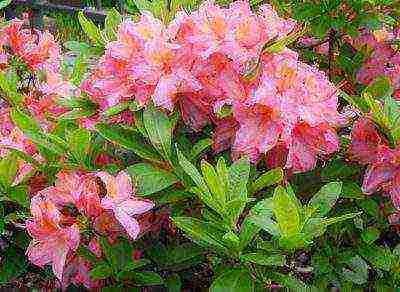 Watering - the plant loves water, in hot weather it is necessary to water it often (1 - 2 times a week, even if necessary), in cool weather, of course, the amount of water used decreases. It is easy to navigate here by the state of the soil - as soon as the top layer of the soil dries up, we water it. If the bush is young, then 2 buckets of water will be enough for one watering, and for a large adult bush you need at least five buckets.
Watering - the plant loves water, in hot weather it is necessary to water it often (1 - 2 times a week, even if necessary), in cool weather, of course, the amount of water used decreases. It is easy to navigate here by the state of the soil - as soon as the top layer of the soil dries up, we water it. If the bush is young, then 2 buckets of water will be enough for one watering, and for a large adult bush you need at least five buckets.
The water must be soft, it would be good to use water from a pond or rainwater. Also, once a month, it is advisable to pour water slightly acidified with lemon.
- Pruning - this shrub has a remarkable ability to form a crown on its own, so no special pruning is needed. After the end of flowering, you only need to remove wilted flowers and you can shorten too long branches (or broken ones) a little.
- Mulching - this needs to be done constantly, the best material for mulch will be coniferous needles, if there is a problem with them, then you can mulch with chips (preferably pine) or sawdust. Periodically, it will need to be added and updated. It is necessary to pay attention to the fact that the mulch should not be close to the stem, there should be a small free space.
- Spraying - in the summer, you definitely need to support Azalea with this pleasant procedure. Firstly, spraying increases the moisture around the plant, and secondly, it helps to protect against various harmful insects. Only you need to use water that is warm, settled or rainwater.
- Protection - the best protection is the observance of all agrotechnical rules and the correct choice of the planting site.
- Care errors - the most common mistakes are too frequent watering of the plant and the introduction of excessive doses of fertilizers, because of this, the root system first begins to suffer and the plant will stop blooming, and if the situation is not urgently corrected, it may die.
We are watching a video about unpretentious garden azalea care:
Prevention of various problems in a garden flower
For prevention, it is worth treating the shrub with Bordeaux liquid several times per season, and in early spring (before flowering) it should be sprayed with Oxyhom and after flowering with Fundazol. Well, and the most important thing is to take proper care of it, so that the prerequisites for problems are not created.
Diseases
- Snails and slugs can settle on the Azalea bush - you just need to collect them by hand.
- Can settle in: mealy worm, scale insect, aphid and rhododendron bug. It is worth first rinse the bush with water using a hose, and then treat it with "Karbofos" or "Diazin".
- The appearance of various fungal diseases is possible (due to excess water). In this case, a fungicide treatment is needed.
- The most common disease is calcareous chlorosis, the leaves change their color - at first they brighten, then turn yellow. It is easier to prevent it than to cure it - you need to put peat under the bush.
- If the stems begin to turn yellow and wilt, this means that the shrub has fallen ill with fusarium. Treatment with Fundazol will help.
Conclusion
Many people notice the fact that when you first get acquainted with Azalea, at first it is scary to settle this beauty in your garden. You involuntarily wonder if it is generally possible to plant it on the street? Will it take root or not? But as soon as one plant takes root, then immediately there is a need to plant more and more. I would like to plant shrubs of other colors, and other forms, in order to decorate just everything around with these chic exotics.
Natalia Kombarova • 03/02/2018
Rhododendrons are beautiful ornamental plants of the heather family. They are difficult to grow in our climate. Their homeland is subtropics, so they love warmth and do not winter well in a harsh climate.
Rhododendrons are sissies. In order for them to grow in the climate of the middle zone, it is necessary to follow the rules of agricultural technology and the subtleties of care. But rhododendrons are so fascinating that more and more gardeners are paying attention to them. Before purchasing planting material for a plant, learn about the nuances of growing.
Despite the fact that rhododendrons are a novelty for modern flower growers, they were cultivated in Russia already at the end of the 18th century, so let's turn to the domestic experience of growing "alpine roses" - this is how the garden rhododendron is called in Europe.
Plants prefer spring planting. They are planted in a dormant state or at a time when the buds have just begun to awaken. Planting in spring allows the seedling to grow stronger and better endure the coming winter.
The key to successful cultivation is the correct selection of the variety. In decorative floriculture, several types are used. For beginners, p. Ledebour, short-fruited, largest and Japanese. On an alpine slide, you can plant Canadian, dense and Kamchatka. These species have increased winter hardiness, so there is a chance that they will survive after a harsh winter.
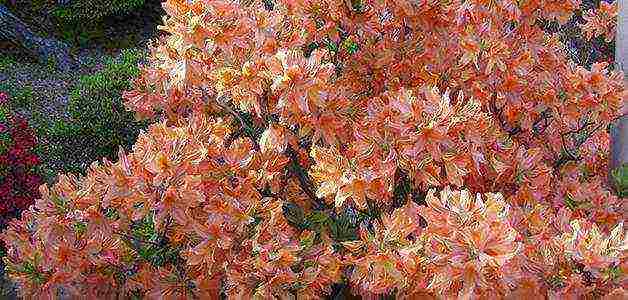
The Japanese rhododendron is beautiful from spring to late autumn. He has large flowers of orange tones. This is the largest and most beautiful bush that can grow in the middle lane. It reaches a height of 200 cm.
It is better to purchase planting material from experienced gardeners or nurseries. Fairs and bazaars do not guarantee the quality of the seedlings. In addition, sellers at fairs often do not know what they are selling. If you unknowingly acquire a capricious look, then it will take root and start growing, but freeze in the first winter.
Landing begins with choosing a seat. All types of rhododendrons grow well in places protected from the wind and hot midday sun. If you plant flowers from the north or northeast side of a building or fence, then this planting can be considered correct.
When planting a rhododendron in the ground near a house, you need to take into account that water will flow from the roof in the spring, and the rhododendron will not like it.You can not plant seedlings next to trees that have a superficial root system, and this is the majority of trees in the middle lane, except for pine and oak. The rest of the trees will compete with the rhododendron for water and food, and as a result, the alpine rose will wither.
You can plant rhododendron under fruit trees, but you need to be prepared that fruit trees will reduce the size of the crop. In order for the bush to show itself in all its glory, it is better to plant it not under the crown of a fruit tree, but further - so there will be enough sunlight for everyone and the bush will bloom magnificently.
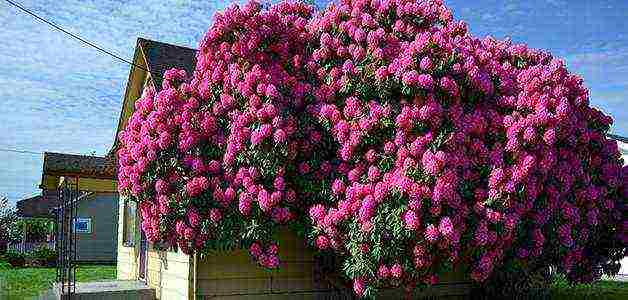
Owners of open blown areas should do the following:
- In the fall, hammer in the stakes from the south and west sides of the bush.
- In early February, fix the shading material on the stakes.
The height of the shelter should be one and a half times the height of the bush. Shelter is necessary to protect the plant from early spring burning.
Rhododendron lays flower buds at the end of summer, and in mid-February in the middle lane the sun begins to bake and large flower buds evaporate moisture. By the time the roots begin to suction work (in April), the buds will have time to dry out and there will be no flowering.
The Canadian rhododendron is resistant to early spring burning, but the most popular types: Japanese, large-leaved, evergreen burn almost annually. A shelter in February-March will save flower buds from death and the plant will bloom magnificently in the current season.
The alpine rose has compact fibrous roots located at a shallow depth, so the plants can be transplanted painlessly at any age. Rhododendron loves moisture, but if the water table is above one meter, drainage will be required.
After choosing a site, the most important point in planting a rhododendron is to prepare a substrate with the correct acidity and mechanical properties. The Ph of the substrate should be in the range of 4.5-5.5. In addition, the soil mixture should be loose, moisture-absorbing, and breathable.
These requirements will ideally be met by a substrate made from acidic high-moor peat, loam and litter taken from a pine forest. All components are mixed in equal proportions. Instead of loam, you can use clay, taking it half the size of the rest of the ingredients.
You can not plant rhododendron in high moor peat or in a mixture of peat with needles. It is imperative to add clay or loam, which will give the substrate the desired moisture capacity. In pure peat, plants will suffer from a lack of moisture, and rhododendrons do not like this. In addition, the soil makes the substrate loose and breathable.
Remembering that the roots of the rhododendron do not grow in depth, but in breadth, the planting hole is made shallow, but wide. Optimal size:
To fill a hole of this size, you will need 8-10 buckets of high-moor peat mixed with coniferous litter, and three to four buckets of loam.
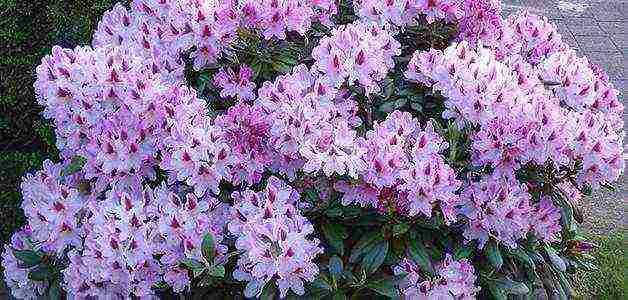
The components of the prepared substrate are mixed and poured into the pit. In the center of the hole, a recess is dug into which the seedling is planted.
If the seedling was sold with a lump of earth (and in the case of rhododendrons, this is most often the case), then before planting its lower part is immersed in water and removed when air bubbles cease to appear on the surface.
The seedling must be planted at the same depth as it was in the container. It is impossible to deepen the root collar - this is important. The planted seedling is watered abundantly and the soil is mulched with a 5 cm layer of pine litter.
When planting rhododendrons, manure, humus, black soil, compost leaves should not be introduced into the pit.
Alpine rose refers to plants that need to be planted correctly, and then for many years you can limit yourself to minimal care. In the first year after planting, it is important that the plant does not experience a water shortage. The planting hole should be constantly wet, but you do not need to loosen it, since you can disturb the young growing roots, which will be located in the surface layer of the substrate.
The weeds that appear in the planting hole are pulled out by the roots, without digging. It is better to use soft water (not well water) for watering.
Rhododendrons love feeding. Keeping in mind the fragile superficial roots, it is better to use solutions for feeding not granules and powders, but solutions. The usual Kemira Universal works well. The granules are dissolved in water according to the instructions and the plants are watered every two weeks.
In early July, the plants are fed for the last time. For this, potassium sulfate is used - a teaspoon per 10 liters of water for young plants and two teaspoons per 10 liters for adults. In July-August, no feeding is carried out.

What can not be fertilized with an alpine rose:
- ash - it alkalizes the substrate;
- manure and manure compost - fungal diseases will appear.
Growing rhododendrons is often accompanied by such a phenomenon as chlorosis. The leaves turn yellow, while the veins remain green. Symptoms indicate a change in the pH of the substrate to the alkaline side.
The growing conditions for rhododendron are such that the plant can only survive in acidic soil. To eliminate chlorosis, acidifiers are used - special preparations that can be bought in garden stores. Industrial acidifiers contain a lot of nitrogen, so they can only be used in spring.
For the prevention of alkalization, you need to mulch the bushes with rotted needles annually. No special measures against chlorosis will be required if you use special fertilizers for rhododendrons to feed the plants and mulch the planting hole with pine or spruce needles two or three times a season.
Special studies have helped to find out the correct thickness of the mulch layer in winter, depending on the size of the bush:

